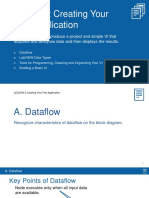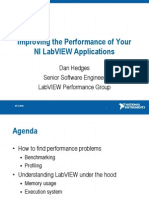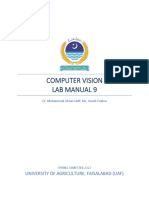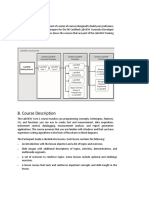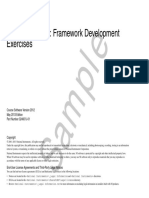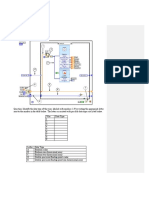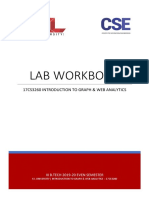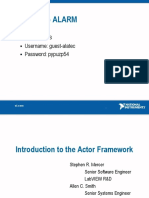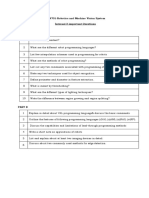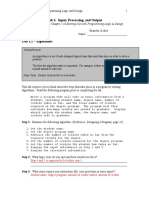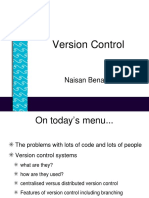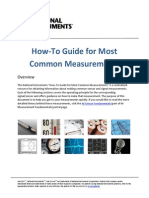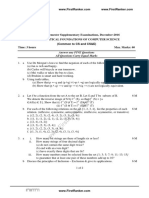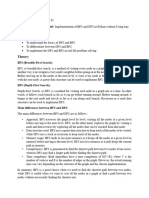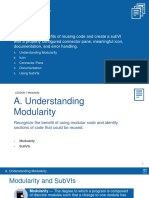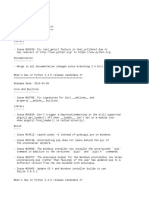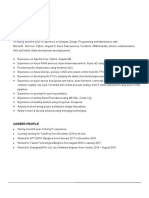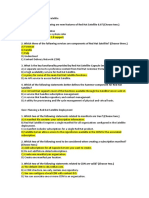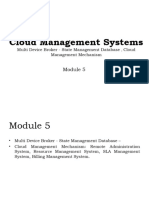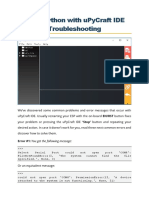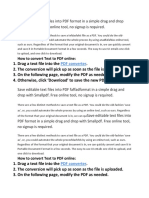Lesson 3
Troubleshooting and Debugging VIs
Fix a broken VI, debug incorrect results and behavior of a
running VI, and display errors generated by functions while
a VI is running.
A. Correcting Broken VIs
B. Debugging Techniques
C. Error Handling
1
�LESSON 3 Debugging and Troubleshooting
A. Correcting Broken VIs
Recognize an unexecutable VI and restate common
problems.
2
�A. Correcting Broken VIs
Common Causes of Broken VIs
3
�A. Correcting Broken VIs
Identify Problems and Fix Broken VIs
4
� LESSON 3 Debugging and Troubleshooting
B. Debugging Techniques
Identify the LabVIEW tools for debugging and select the tool
appropriate to the situation.
• Debugging Tools Review
• Breakpoints
• Undefined or Unexpected Data
5
�B. Debugging Techniques
Debugging Tips
Refer to the LabVIEW Core 1 Participant Guide for the Debugging Techniques job aid.
6
�LESSON 3 Troubleshooting and Debugging
Activity 3-1
Review Debugging Tools
Select the LabVIEW debugging tool you would use in different scenarios.
7
�B. Debugging Techniques
Breakpoints
8
�B. Debugging Techniques
Retain Wire Values
• Allows you to probe wire values after a VI runs
9
�B. Debugging Techniques
Undefined or Unexpected Data
10
� LESSON 3 Troubleshooting and Debugging
Exercise 3-1
Debugging
Use debugging tools and troubleshooting techniques to fix a broken VI that
returns unexpected data.
11
� LESSON 3 Troubleshooting and Debugging
Exercise 3-1
Debugging
• If you have a VI with a broken Run arrow, what should you do first?
• After you fixed your broken Run arrow, your VI results show unexpected data.
What can you do next?
12
� LESSON 3 Debugging and Troubleshooting
C. Error Handling
Describe the difference between automatic and manual error
handling.
• Error Handling Review • Error Clusters
• Automatic vs. Manual Error • Errors and Warnings
Handling
• Merge Errors Function
13
�C. Error Handling
Error Handling Review
Error Handling – Anticipation, detection and resolution of
warnings and errors
Automatic Error Handling – At run time, LabVIEW suspends
execution, highlights node, and displays Error dialog box
Manual Error Handling – You control when dialog boxes
appear, propagate errors with error clusters, terminate error
chain with Simple Error Handler VI
14
�LESSON 3 Troubleshooting and Debugging
Demonstration
Automatic vs. Manual Error Handling
Demonstrate the difference between automatic and manual error
handling.
15
�C. Error Handling
Disable Automatic Error Handling
16
�C. Error Handling
Error Clusters
17
�C. Error Handling
Errors and Warnings
Error Warning
• Status = TRUE (8) • Status = FALSE (4)
• Code = Non-zero • Code = Non-zero
18
�C. Error Handling
Merge Errors
19
�C. Error Handling
Errors and Warnings Recommendations
20
�LESSON 3 Troubleshooting and Debugging
Activity 3-2
Lesson Review
Refer to the participant guide to answer questions about what you have learned
in this lesson and then discuss the answers as a group.
21
�Lesson Review
1. Which of the following will result in a
broken run arrow?
a. A subVI is broken
b. The diagram includes a divide by zero
c. A required subVI input is unwired
d. A Boolean terminal is wired to a numeric indicator
22
�Lesson Review
1. Which of the following will result in a
broken run arrow?
a. A subVI is broken
b. The diagram includes a divide by zero
c. A required subVI input is unwired
d. A Boolean terminal is wired to a numeric indicator
23
�Lesson Review
2. Which of the following are the
components and data types of the error
cluster?
a. Status: Boolean
b. Error: String
c. Code: 32-bit integer
d. Source: String
24
�Lesson Review
2. Which of the following are the
components and data types of the error
cluster?
a. Status: Boolean
b. Error: String
c. Code: 32-bit integer
d. Source: String
25
�Lesson Review
3. All errors have negative error codes and
all warnings have positive error codes.
a. True
b. False
26
�Lesson Review
3. All errors have negative error codes and
all warnings have positive error codes.
a. True
b. False
27
�Lesson Review
4. Merge Errors function concatenates error
information from multiple sources.
a. True
b. False
28
�Lesson Review
4. Merge Errors function concatenates error
information from multiple sources.
a. True
b. False
29
